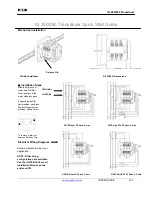
DW1000 User Manual
© Decawave Ltd 2017
Version 2.12
Page 228 of 242
Both of the above schemes are denoted
ASYMMETRIC
because they do not require the reply times from
each device to be the same.
Using this scheme, the typical clock induced error is in the low picosecond range even with 20 ppm crystals.
At these error levels the precision of determining the arrival time of the messages at each of the receivers is
a more significant contributor to overall T
prop
error than the clock-induced error.
Where the clock in device A runs at k
a
times the desired frequency and the clock in device B runs at k
b
times
the desired frequency and both k
a
& k
b
are close to 1.
To give some idea of the size of this error, if devices A and B have clocks where each are 20 ppm away (the
worst case specification) from the nominal clock in directions which make their combined error additive and
equal to 40 ppm, then k
a
and k
b
might both be 0.99998 or 1.00002.
Even with a relatively large UWB operating range of say 100 m, the TOF is just 333 ns, so the error is 20 × 10
-6
× 333 × 10
-9
seconds, which is 6.7 × 10
-12
seconds or 6.7 picoseconds which is approximately 2.2 mm.
Again note that achieving these error levels does NOT require the use of the same response time at each
device.
At these error levels the precision of determining the arrival time of the message is actually the more
significant source of error.
Advantages
Drawbacks
Reply times need not be the same – gives great
flexibility in the design of use cases and application
scenarios
Requires multiplication and division operations
Error in the calculated time-of-flight is minimized
12.3.3 Using symmetric reply times
This is a special case of the double sided scheme known as
SYMMETRIC
Double-sided Two-way ranging in
which T
reply1
and T
reply2
are restrained to be equal (or as close to equal as possible). In this case:
This scheme requires only addition, subtraction and division by 4 which is easily achieved in low power
micro-controllers however it results in the entire exchange taking longer than necessary.
It can be difficult to achieve a situation where the reply times at each device are the same although the use
of the DW1000 delayed send feature simplifies this; the calculations required at each device may not be the
same. For example, the final message from device A to device B will often need to embed the send and
receive times into the packet so that device B can calculate the time of flight. If symmetric delay times are
required, the whole round trip exchange will need to be expanded to accommodate this. When the response
delays are flexible, the exchange can be faster.















































